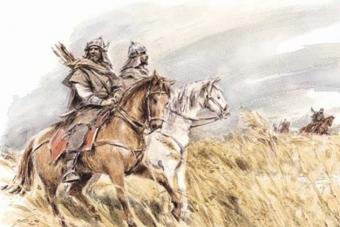Sheep wool is one of the most valuable products sheep breeding. All breeds can be classified as fine-wooled, semi-fine-wooled, coarse-haired or semi-coarse-haired. Timely shearing of sheep allows you to get excellent products, the demand for which is much higher than that of lamb meat.
Terms and frequency of haircuts
Fine-fleeced and semi-fine-fleeced sheep serve as the source of the most popular fleece in light industry. They can only be sheared once a year, provided that the sheared wool is 3–3.5 cm long, respectively. This is possible if the hair on the sides, back and shoulder blades of rams reaches a length of 4–5 cm.
Usually a haircut is carried out in the spring. However, young winter lamb that are born between January and March are sometimes sheared in the summer (July or August), strictly following the standards of the length of the bright wool.
At the same time, sheep shearing in the spring is carried out in different dates. They depend on the climatic zone, as well as on the condition of the rams themselves and their coats. In the south, sheep are sheared from the end of April. In other latitudes, mass shearing is postponed to the middle or end of May, when warm weather sets in.

In terms of timing, they are guided by the amount of fat. In winter, it is not enough and, as a result, the wool becomes stiff and dry, so they wait until the fleece becomes soft and elastic, which will preserve the integrity of the wool layer during the shearing process.
It is not worth delaying the haircut. When burdocks and other grasses clinging to hairs appear on pastures, it will be very difficult to do this, and the quality of the resulting product will decrease.
With coarse-haired and semi-coarse-haired breeds, the situation is slightly different. Such sheep are subject to seasonal molting in spring. In order not to lose wool products, it is necessary to carefully monitor when the tucking process begins. This is the optimal moment for shearing: the fleece comes off without undue effort on the part of the shearer. Coarse-wooled sheep are sheared 2 times, and the Romanov breed of sheep 3-4 times a year.
Coarse or semi-coarse hair must be trimmed in any case. Even if you do not find a use for it, otherwise the sheep will suffer from the heat, which will provoke a deterioration in appetite and a delay in weight gain. Lambs are sheared for the first time at the age of 4-5 months.
Basic ways
Before the total mechanization of all processes in agriculture, sheep shearing was carried out by one the only way– manually. For this, there are special scissors that allow you to make a comfortable grip with your hand. Of course, the haircut is not done quickly, but with high quality: the fleece is cut very evenly. Traumatism of rams in the process is minimal. In addition, the blades on such scissors are easy to sharpen.

Until now, manual labor is used in farms where there is no a large number of sheep. But the maintenance of large flocks requires the presence of a sufficient number of machines for shearing sheep.
The method of processing sheep with a machine and scissors differs little. In both cases, if you have experience and skill, you can use not only a regular haircut, but also use a high-speed method. This is the pinnacle of excellence when:
- All passes are carried out confidently, without significant effort.
- The shearer deftly changes the position of the sheep's body, in accordance with the direction of the shearing.
- The minimum number of movements and passes is carried out.
- In the process of cutting, not only the working hand is involved, but the whole body. Experienced shearers keep the position of the sheep and change it with their feet. Usually, right hand they shear the sheep, and they help the left, grabbing the skin into folds, covering the nipples of the females, removing and pushing the wool.
In any case, preparation for shearing sheep with scissors or a machine is carried out in advance. In order not to miss the moment and not lose woolen products, it is necessary to carefully study how to shear sheep. If possible, train on experienced individuals under the supervision of specialists.
Haircut rules and technique
Sheep are sheared in a specially designated area. Definitely light and dry. Wooden boards, tables, or tarpaulins are pre-prepared to prevent wool loss.

Sheep shearing is carried out in several stages:
- The animal is placed with its back to itself on its left side.
- Carefully free the surface of the body from dirt.
- Cut off the tails. They walk around the udder, covering the nipples with their hands. Take the pieces off inner surface thighs on the legs. Immediately put them separately.
- With one pass between the inguinal folds of the right pair of legs, you need to cut a continuous strip. It is more convenient to move from the back to the front.
- The abdomen and chest are sheared along longitudinal lines, starting from the lower abdomen or from the udder.
- Gently turn the ram over to the other side. Standing facing the belly, they take the sheep by the hind limb and cut the croup first, gradually moving towards the left shoulder blade.
- After that, the lower back, side, withers are trimmed with continuous longitudinal passages. Movements are made to the spine. The ram is fixed in such a way that, under the action of gravity, the sheared layer falls to the floor.
- Again, the sheep is laid on its left side, while changing its location and becoming facing the animal's stomach.
- The croup and right shoulder blade are cut first, then the right side and back are completely cut off with the help of long longitudinal passages.
- Taken by the neck and head. Cut the right side first. The movements are perpendicular to the spine. Then, raising his head, left side.
- The resulting layer of fleece is moved away from the ram.
- Raise the sheep to its feet and release it outside the pen.
Scissors cut in the same sequence. When cutting with a machine, make sure that the comb is always in contact with the skin. They don't stay in one place. Otherwise, due to the “cuts”, the quality of the haircut is reduced.

- It is much easier to shear sheep that have maximum fatness. Their fleece is perfectly saturated with grease, and the surface of the body is even and dense. Few well-fed sheep have an uneven relief of the body, a dry and loose coat.
- About 1–1.5 months before shearing, experienced sheep breeders carry out a preliminary trimming. This allows you to clean from dirt and significantly speed up the process of the main haircut in the future. In addition, pre-cutting contributes to the safety of the machines, preventing premature replacement of parts. There is also no need to frequently sharpen knives or shearing shears.
- Sheep should not be fed before shearing. In well-fed animals, problems with the gastrointestinal tract can begin, which are fraught with their death, for example, intestinal volvulus. Exposure without food should last at least 12 hours.
- The fleece obtained as a result of a haircut must be spread on a flat surface, outer side up and clean thoroughly. Store rolled up so that the outer part does not touch the inner.
- Within 2 weeks from the moment of shearing, it is recommended to leave the sheep near the covered areas, do not drive the flocks to distant pastures in case of adverse weather. Since during this period the sheep are most vulnerable. sharp fluctuations night and day temperatures, precipitation and cold winds can make a significant breach in the immunity of sheep. To prevent them from getting sick, they need to be protected from the weather.
Instrument Care
Having learned how to properly shear sheep, it is also important to pay attention to the tools. Only with proper care of the equipment can high speed and good quality rune.
Sharpened, lubricated and comfortable scissors help minimize manual cutting effort. They provide a rune High Quality. AT industrial environment scissors are used less and less, as manual shearing increases the cost of the resulting product at times. Demand for piece goods is limited.
Sheep clippers allow you to shear sheep much faster than by hand, so they are used almost everywhere, even in the smallest farms. The machine is assigned to each specific shearer who is interested in its performance.

After cutting, the machine must be cleaned. Including:
- Knives are freed from the remnants of hair and fluff with a brush.
- Wipe the remaining parts of the mechanism with a soft cloth or napkins.
To increase the life of the machine, do not use aggressive reagents and solvents. All nodes must be lubricated engine oil after every haircut.
If during operation you have to make significant efforts, the passes of the machine become uneven, and the quality of the haircut drops, it means that it is necessary to replace the cutting surfaces or sharpen them.
After cutting, be sure to follow the rules for storing the machine:
- Do not allow high humidity in the room where it is stored.
- It is recommended to use the machine exclusively for rams and sheep, not using it for shearing other farm animals.
- Sheep shearing knives must be kept in special sheaths.
Wool cut by hand, with scissors, is considered too expensive all over the world: a lot of time and effort is spent on it. Yes, and large flocks of sheep leave no choice. In order to save labor costs and the amount of time for processing each ram, it is more efficient to use clippers. If you calculate the timing correctly, get your hand on other breeds, then a mechanized haircut allows you to get a result no worse than with scissors, and definitely faster.
In one American cartoon, very pathetically - with singing - the story of a lamb is described, which is terribly worried about shorn wool. A very deep and even philosophical conclusion is drawn from this story - everything is transient, everything has its time, and curls will also grow back to be cut again ... It is unlikely that such philosophical reflections available to real sheep and rams - but let's try to imagine: what awaits these animals if their regular shearing is stopped? After all, no one, in fact, sheared their wild ancestors - that, by the way, is the scope for the vigorous activity of all kinds of “animal advocates”, who will probably be happy to declare the shearing of rams to be some kind of torture of unfortunate animals ...
Yes, of course, there was no one to shear the wild ancestors of modern domestic sheep, and most importantly, they did not need it. But modern domestic sheep are very different from them! After all, when a person domesticated any animal, he always engaged in selection, in other words, artificial selection: from the offspring he selected and crossed only those individuals in which the characteristics that were of interest to man were especially pronounced. Of course, such methods were not as accurate as modern Genetic Engineering, and as a result, in addition to one useful trait, it was possible to get a lot of traits ... let's say, problematic (which is why with cultivated plants and domestic animals - unlike wild ancestors - you have to "baby" so hard), but on the whole it turned out well.
With regard to sheep, wool was such a sign: the thicker it is, the better for a person! So much wool is not required to protect from the cold, moreover, it can seriously interfere with the animal, especially in summer. If the weather is hot, such an animal feels unwell and loses its appetite, especially sheep that feed lambs suffer from this - because if a sheep eats poorly, it will not have enough milk, which means that the survival of the lambs will also be at risk.
In a word, leaving growing wool to domestic sheep and rams is not only harmful to such animals, but even dangerous. That is why sheep are sheared, even if there is no urgent need for their wool and is not expected in the near future. In agriculture, in the old days, a special profession even stood out - “shearer”, the so-called specialist in shearing sheep. Sheared sheep with scissors - single, the cheapest and simplest, or double, and such a tool was selected specifically for the shearer's hand. In modern times, especially in large farms, sheep are more often sheared with special electric machines.
Shearing sheep is not an easy task. Animals are sheared before feeding, and only when their hair is dry, and they do it with extreme caution - after all, on the one hand, it is necessary to cut it as close to the skin as possible, and on the other hand, to prevent damage to it. This is not so easy, given that sheep are still unreasonable creatures and do not understand the need for such a procedure - and can resist, therefore, before shearing, their legs are bound to be bound. But it is still not always possible to avoid cuts, therefore, after a haircut, the animal is carefully examined, and if cuts are found, they are lubricated with a disinfectant.
Buying high-quality domestic sheep clippers is a must for anyone who keeps these animals in their household. Sheep are not only a valuable source of meat, but also a renewable product such as wool. It is precisely because wool grows back, which means that it can be obtained from each sheep many times, unlike meat, keeping sheep and rams for the sake of wool is quite profitable. But in order to benefit, you need to properly cut the animal. This requires suitable tools, as well as certain skills related to cutting techniques. What is best to use in work and how to cut an animal and will be discussed Further.
In order to shear these animals, various tools can be used, such as clippers, electric scissors and others. Each of them has both its pros and cons.
Reviews on the Internet from experienced owners of such tools will help you decide. Despite the fact that scissors are the oldest and classic tool for removing hair. This does not mean that you should immediately choose them, perhaps you will find modern tools more convenient. The characteristics of the tools were based on reviews about them from experienced professionals. It is also worth listening to a video with comments from experienced professionals, because removing wool is a whole profession with its own subtleties.
cars
Modern electric sheep clippers are suitable for those who need to provide a fairly reliable and fast shearing without the serious physical effort that is required when working, for example, with scissors. The technique of working with a machine is quite simple, although it requires certain skills from the shearer.
Economical options for machines are suitable for working with small flocks. However, they cost a lot more than scissors, so if you only have 1-2 animals, it's worth considering whether these expenses are reasonable. When choosing a specific model of a sheep clipper, be sure to pay attention to reviews about it on the Internet.
Scissors
As mentioned above, this is a classic option. Many still prefer it today, based on reliability, simplicity and efficiency. An experienced shearer, even with the help of them, can cut an animal for a very short term. According to reviews, this is a universal tool that can cope with the hair of almost any individual.
There are two main types of scissors:
- Single. This is the simplest version of the tool, which is ideal for use in small farms. But working with such a tool requires a person to exert sufficient physical effort and have a certain skill.
- Double. More perfect option. They must fit under the arm of the person who will work with them. In their design, they have a number of differences, and some models are made with a bend, which facilitates the whole process and makes it smoother. Here it is also worth choosing a specific model, focusing on the reviews of other owners.
Electric scissors
Electric scissors are a type of machine. Some experts do not distinguish them in separate group. Such tools with high reliability are capable of shearing a large number of sheep and rams for a relatively a short time, but working with them requires special skills from the shearer. This is evidenced by reviews of similar tools on the Internet. Therefore, it is necessary to choose electric scissors carefully.
How to shear sheep
Even if you have chosen what you will work with, you should not relax - the haircut process must be approached responsibly and following a number of simple recommendations.
- First, check the condition of the tool, if necessary, gently clean the mechanism of the clipper, make sure that the electric scissors work, sharpen the blades, etc., so that the tools are ideally prepared for removing hair.
- Remember that the whole procedure should be carried out before feeding and watering, and the wool must be absolutely dry - if the sheep gets wet in the rain, the shearing should be postponed. Otherwise, reviews about the wool of your animals from buyers will not be flattering.
- Also prepare a separate room for the procedure.
Shearing process
After you have prepared everything you need, the actual work begins. First, you need to tie the animal. Moreover, only three legs out of four are tied, while the latter is left free to remove wool in the process.
The procedure has a certain order. The head is cut first, then the neck, chest and groin of the leg you left unbound. After that, you can begin to cut the side, as well as the back and tail of the animal.
After you are done with this, turn the animal on its other side and bandage its legs again. Then you need to act in the following sequence: first the side, followed by the shoulder blade, then rear end belly and, finally, groin.
Be careful not to cut the same place twice - this will damage the quality of the coat in the future.
After you are done, you need to put the scissors aside and fold the wool properly. The one that you removed from the tail, belly and legs should be set aside separately from the rune. Also, be sure to set aside dirty pieces of wool, as they should not be mixed with clean wool unless you want to degrade its quality in the end.
To keep the reviews of the wool you sell always high, you need to choose the right tool, acquire the right skills and take care of your animals.
Video « Clipper haircut »
From the video you will learn how to cut the hair of these animals using a machine.
Timely shearing of sheep is a guarantee of high quality wool, as well as a process that will prevent loss and defects of wool.
Sheep before processing
When should sheep be sheared?
When should sheep shearing take place? Usually they are sheared depending on which direction of productivity they belong to, but a sheep clipper is always used for this. If the ram or sheep has uniform wool, then the procedure is carried out in the spring once a year.
If the animal has a mixed coat, then it is sheared twice, preferably with the onset of spring and autumn. Some coarse-haired breeds can be sheared even three times a year.
Lambs with non-uniform coats should be sheared from the age of five months (best if it is in the summer). If the lambs have thin or semi-thin wool, then the haircut should also be started at the age of five months, but only if by that time the wool itself has grown to four or more centimeters.
To shear a sheep, you need to correctly set the timing for this procedure (taking into account weather factors and how much the animal is overgrown with wool). Regardless of what climate zone you are in, the main condition for correctly determining the right time for a haircut is the constancy of warm weather (due to the fact that the animal can get sick after the hair is cut off).

Shearing sheep with scissors
But even in the very heat, you do not need to shear a ram or a sheep, because in the heat the animal can lose its appetite, become exhausted. In addition, during this time, the wool can become clogged with various plants such as burdock, as a result of which the haircut will become difficult, and the quality of the wool will decrease. Another rule for shearing a ram: it must be sheared when the wool has already begun to tuck.
A rough-haired ram needs to be sheared on time, otherwise there is a risk that it will lose half of the wool, because as soon as it starts to warm up, the molting period will begin. Therefore, fluff will be lost - the most valuable cover of wool.
The single term for shearing all sheep is spring period, and the approximate dates are from the end of May to the beginning of June. The period of the second haircut captures the end of August and the beginning of September (so that when the cold comes, the animals restore their coat).
Sheep need to be prepared for the procedure: do not feed during the day, do not water for about twelve hours (if the animal full stomach, it is very difficult for him to withstand a haircut, in addition, the coat can be contaminated with urine). In the event that the woolen cover of a ram or sheep is wet, you need to wait for it to dry completely, since wet wool can quickly deteriorate.
The main rules for haircuts
The main factor in order to properly shear a ram is a bright room. In this room there should be tables covered with tarpaulin (so that the wool does not become dirty and is not lost).
There are two haircut methods:
- mechanical (it uses a machine for shearing sheep);
- manual (using scissors).
At the first shearing, the process is a little easier, because the knives that the sheep clipper has quickly cope with the task.
Hand shearing, on the other hand, produces better products because the wool is sheared as close to the skin as possible (this especially affects the shearing of fine-haired sheep - with hand shearing, the fleece becomes longer and the payment increases).
During the process itself, it is important to ensure that the knives do not come into contact with the skin of the animal, whatever one may say, and this is a very painstaking work that requires accuracy. You can not cut the same place twice, otherwise the quality of the fleece woolen cover will decrease in the future. Wool sheared from the belly, legs, is packed in a separate bag from the fleece. It does not matter whether the sheep should be sheared on the table or on the floor: the main thing is that the necessary conditions have been observed.

Removing hair from an animal
For a proper haircut, you need to do the following:
- the sheep should be positioned with its back to you, in this position its legs should not rest on anything. At this time, free the wool cover from weeds and dirt;
- first of all, the tails, thighs (their inner side), front and hind legs, the woolen cover around the udder are cut; this hair is deposited (when shearing takes place around the udder, the nipples should be covered so that the knives do not injure the animal);
- the strip is cut, starting with the right hind foot from inguinal zone and ending with the groin of the right front, then the abdomen and chest are trimmed with the same stripes;
- the machine is turned off, set aside so that the knives do not injure the sheep while turning it over to the other side;
- croup and left shoulder blade are cut;
- the lower back, right side are cut in stripes. Moreover, you need to hold the sheep as conveniently as possible so that the fleece that is sheared falls on the floor (or table) itself;
- the machine is turned off, then it is necessary for the animal to turn over again on its left side, then it must be sheared right shoulder blade and cereals;
- the back is cut in long stripes;
- next the head is cut, the neck with right side to cut the wool in the folds, the machine must be turned to the transverse position (in this case, you need to be very careful and keep the knives as far as possible from the skin itself);
- the sheep's head rises and is sheared left side neck, after which the sheep clipper is finally turned off, and the sheared fleece is pushed aside from the sheep itself;
- the sheep is carefully picked up and released.
If the haircut takes place at home, then most often it is carried out not with a machine that has knives, but with ordinary scissors, and the order of execution is the same. important procedure after the end of the shearing process, the sheep are examined, during which their hooves are cut off a little, the cuts left by the machine are disinfected (with any antibacterial solution).

So they shear a sheep with a machine
The cut fleece is spread outward on the surface of the table, straightened, shaken, cleaned of dirt and dust, yellowed wool. After the cleaning procedure, the fleece is rolled into a roller, in this form it is stored until the next use.
Sheep clipper care
Quite often they ask, how to take care of a sheep clipper? One of important conditions is precisely the observance of hygiene when working with the device.
How to clean the machine:
- after the sheep clipper has been in use, the knives must be cleaned of the remaining wool, for this you can use a brush;
- the device itself should be wiped only with soft cloths;
- should not be used to clean the machine. special means or solvents;
- in order for the device to work without interruption and serve you for more than one year, you should regularly lubricate the knives with oil, ideally after each use of the machine;
- if the quality of the haircut decreases (despite the fact that you regularly clean and lubricate the device), then you should replace or sharpen the knife block;
- the sheep clipper should be stored only with protection on the knives (this may be the protective cap included in the kit and others);
- do not use the shearing knives of these animals for shearing other animals or people.
Sheep shearing can be mechanical or manual. The quality of the manual is better, but the price of the fleece is higher. If you do not want to bother yourself, then a sheep clipper will greatly facilitate this matter. The process of shearing wool itself takes place according to a certain algorithm, and after a while your hand will already be full.
It is important not to forget to separate ordinary wool, like from the legs of a sheep, from the desired fleece, which is sheared on the chest. For a quality haircut, you need to follow certain rules cleaning and storing the machine. The process of shearing a sheep seems very difficult, but soon shearing will not cause you any difficulties, it will become a habit, and the acquired skills will help to speed up the work twice.
March, beginning of April is the time for shearing sheep. Spring haircut is obligatory for all breeds. An exception is made only for young animals born in January: these sheep are sheared later, in June, when the wool grows more.
Coarse-haired breeds need a second shearing in the fall, and Romanov sheep and northern short-tailed breeds need a shearing not only in autumn, but also in June.
- 12 hours before shearing (until morning), the sheep stop being fed and watered.
- If the sheep’s wool is wet for some reason, you can’t cut it, you have to wait until it dries.
- They always cut the belly first, then the shoulder blades, thighs, sides - in turn. Moreover, the hair on the sides is cut from the back to the belly.
- Animals must be handled with care. Do not turn the sheep over its back, do not rest your knee on the belly, make sure that the stomach does not hang over the edge of the table.
- Cuts are not allowed! If, nevertheless, this could not be avoided, immediately treat the wounds with iodine, creolin or other antiseptics. In no case do not sprinkle the cuts with earth! Although this method is common in the tradition of sheep breeding, it has been proven that there is a high probability of infecting an animal with tetanus, which will inevitably lead to its death.
- After shearing, inspect each sheep, if there are untreated cuts, process them.
- If the wool is cut too high somewhere, do not cut it further. The admixture of short wool spoils all the long, in the final analysis it is unprofitable.
- The first week after shearing, sheep are allowed to walk only in good weather, and then not far from the house, so that in case of rain, immediately drive the flock into the room. Wool after shearing immediately washed and dried.
Not washed, or poorly dried wool, quickly loses quality: it begins to sag, cake. Soap is usually used to wash wool. soda solution. For 12 liters of water, 180-200 g of soap and 120-130 g of soda. Wash wool in four tanks. In the first tank, 6 liters are mixed soap solution and 24 liters of water. In the second and third - 3 and 12 liters, respectively. The fourth tank is filled with warm clean water.
The wool in each tank is washed for 10 minutes, after which it must be properly squeezed out by hand or in a wringer, and then dried in natural conditions.
But animals are not slaughtered for sheepskin in the spring: the skins at this time come out of very poor quality, with a fragile mezdra. It is economically advantageous to slaughter sheep at the end of summer.
Remember that shearing a sheep is always stressful. They can get sick, hurt, lose their appetite. Therefore, after shearing, sheep need special care, care and attention.





